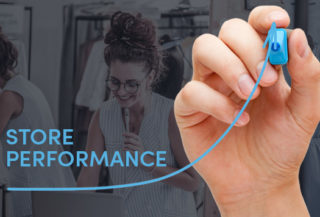Blog Post
New Systems for Better Insights on Store Performance
October 24, 2019 in Performance Management, Thought Leadership

Omnichannel and the connected consumer have dramatically changed retail over the last five years. Yet the method by which we measure store performance and productivity seems stuck in the ‘90s. Today, more digital transactions are taking place in-stores. Services like Buy Online, Pickup In-Store (BOPIS), Ship-from-Store, or Buy Online, Ship-to-Store are growing in popularity – making up a significant portion of overall retail transactions. In BOPIS transactions alone, for instance, orders have increased by 47% in November and December 2018 when compared to the year prior.
Old Metrics Don’t Work Anymore
To analyze in-store performance, retailers must transform the traditional methods of measuring store performance and productivity. The old metrics don’t work anymore. The conventional approach to measure store performance was by analyzing two key components of the retail equation. These are ‘quality of sales’ and ‘quantity of sales’.

Quality of Sales
Quality of sales is how much you sold to a customer. The key metrics to evaluate this are basket size or Average Transaction Value (ATV) and Units Per Transaction (UPT). In other words, quality of sales focuses on the total spend per transaction.
Quantity of Sales
Quantity of sales is how many customers you sold to. The key metric here is conversion rate. This is the total number of transactions divided by the total in-store traffic.
Before the digital transformation in retail, store traffic, sales, conversion rate, and basket size were the key indicators to measure store performance. Today, these KPIs alone don’t give retailers a wide enough view of whether a store should remain open or not. These metrics alone don’t allow retailers to consider the overall impact a store has on their brand.
New Key Metrics to Measure Retail Performance

Today in retail, customer experience, both online and offline, is the key to building brand advocacy and growth. Creating a fantastic and seamless customer experience across all channels will be the deciding factor in separating retailers into those who are creating sustainable growth and those who will struggle.
In today’s omnichannel world, we still see retailers measuring digital and physical channels separately. Even though the term omnichannel itself begs for a single form of measurement, legacy systems and practices have been slow to change. And at the center of this resistance lies the question around who gets credit for what. This legacy silo approach must give way if retailers are to objectively measure performance and make better decisions around their store estate.
How Does Demand Generation Work in Today’s Retail World?
Richard Kestenbaum explains how stores are becoming both, directly and indirectly, involved with digital transactions. As the essential brand touchpoint a retailer has, stores have a direct impact on digital sales in the immediate geographic area. They are the location for handling in-store pickups and returns from digital channels. They even serve as venues for various types of events that are marketed digitally. This means digital and physical channels are influencing each other, and both are playing an essential role in driving customer experience.
Seventy-three percent of consumers touch multiple channels during their buying process. A Gen X’s first touchpoint with a retailer, for instance, could be a social media channel or the retailer’s e-commerce platform. This person might end up purchasing goods at a brick-and-mortar store. On the other hand, a millennial consumer might start its journey at a physical store and finish it by using ship-from-store services when she or he can’t find the specific size or color they want.
What Are the Best Practices to Measure Retail Performance?

First, you must deal with the elephant in the room – “who gets credit?”. The short answer is that it doesn’t matter. Measuring demand generated within the geographical zone that each of your physical stores service allows you to have a single view of how your consumers are responding to your brand within that area. It also brings together both your digital and physical staff with a common view, a common goal, and a common purpose.
It is important here to clarify ‘demand generation.’ In today’s omnichannel world, demand generation and order fulfillment are not necessarily occurring in the same physical place. An order may be placed at one store and shipped from another. And, an online sale may have a different billing and shipping address. For each transaction, you need to ascribe the physical location of the generated demand. In the case where an order is placed at one store and shipped from another, it would be the store where the order was placed who gets the credit. In the case of an online order, it should always be the billing address of the credit card used for the purchase. Any demand generation that doesn’t occur within a store should be geolocated to the nearest store. This is based on the postal code of the buyer’s address (credit card).
While bonus or compensation plans may change as a result, it doesn’t mean that the total spend on these items should as well. Instead, plans should be modified to reflect the new omnichannel realities and goals.
Better Systems for Better Insights

Tools like StoreForce are purpose-built for accurate omnichannel measurements. They allow retailers to geolocate digital transactions to their nearest store. StoreForce enables retailers to asses how each store performs as a market (digital and physical sales combined). Retailers can then drill down from a market view to see digital and physical transactions separately. In this way, both traditional metrics such as basket, UPT, and conversion rate can be measured within each channel – at a store and a combined market level.
Measuring your omnichannel performance in this way provides a more in-depth insight into how your customers are responding to your brand in each geography you operate in. It also allows you to make better decisions on real estate and enables the development of incentive programs that break down the silos between the digital and physical worlds and leave you with a single view of your customer.
Author:

Dave Loat is the President and co-founder of StoreForce. Dave has over 25 years of experience working with some of the best-known brands in retail and has incorporated these learnings into the StoreForce’s solution. He is truly passionate about store operations. Prior to StoreForce, Dave was a founding partner of Karabus Management, which grew to become the second-largest retail-specific consulting firm in the world. While at Karabus, Dave had the experience of working with over 100 retailers.

Recent Blog Posts

Summer Tactics that Get Tourists Choosing Your Store
McKinsey and Company recently shared statistics showing that 2 out of the 3 top areas where consumers spend their money are travel and apparel As temperatures rise and summer sets in, your...
READ MORE
Our Top Three Takeaways From Future Stores 2023
Last week, our StoreForce team flew to Seattle, Washington, to dive headfirst into the world of Future Stores 2023 We mingled with incredible retailers and soaked up a wealth of knowledge we’re...
READ MORE
Become A Multifaceted Store Associate
Allow your store associates to be masters of all things retail! The retail game is changing for your store associates Instead of working in silos, we now need them to master all skills needed for...
READ MORESchedule a Consultation With Our Retail Experts Today
Contact us today for a 15-minute conversation on how StoreForce can help you drive store performance and execution for less than the cost of 1 transaction per week. Learn how retailers all over the world are driving performance and customer experience through our solution made exclusively for Specialty Retail.